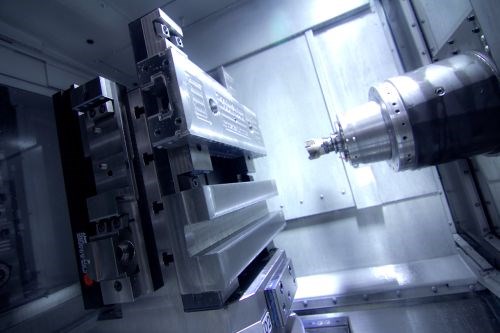A Different Approach to Tool-Break Detection
A standard feature on the CNC of this shop's workhorse machine helps improve confidence in unattended runs.
Share







Mr. Sun’s Mori Seiki NHX4000 pre-bores a pilot hole on a vise body via helical interpolation.
This article from a recent MMS issue describes how low-profile clamps from facilitated the high-density fixturing necessary for one fledgling manufacturer to take full advantage of a twin-pallet HMC with tombstone fixturing. However, just as there's only so much space on a tombstone, there's only so much space in a given article. As such, the piece is by no means comprehensive in its treatment of the strategies that shop owner Eric Sun employs to make the most of his production resources.
One example is his use of tool load monitoring, which comes standard on his HMC's CNC. By writing a simple program that directs the machine to drill portions of the workpiece where material should already have been cut away, Mr. Sun can detect tool breakage without the use of a separate probe. "If we take a small drill and go into an existing hole where there shouldn't be any material, and tool load monitoring measures any load at all, I know the tool broke and the hole wasn't drilled properly," he explains. "This built-in CNC feature provides a lot more confidence for our longer unattended runs."
Of course, this approach is viable not just for drilled holes, but also milled features such as pockets, slots and so forth. Mr. Sun adds that it is also useful for checking setups. For example, he might use tool load monitoring determine whether a fixture that is supposed to be empty actually is so. Likewise, he can ensure that the correct workpiece is loaded in cases when different-size parts share the same fixture for their respective machining routines.
Related Content
-
Orthopedic Event Discusses Manufacturing Strategies
At the seminar, representatives from multiple companies discussed strategies for making orthopedic devices accurately and efficiently.
-
Lean Approach to Automated Machine Tending Delivers Quicker Paths to Success
Almost any shop can automate at least some of its production, even in low-volume, high-mix applications. The key to getting started is finding the simplest solutions that fit your requirements. It helps to work with an automation partner that understands your needs.
-
Quick-Change Tool Heads Reduce Setup on Swiss-Type Turning Centers
This new quick-change tooling system enables shops to get more production from their Swiss turning centers through reduced tool setup time and matches the performance of a solid tool.
















